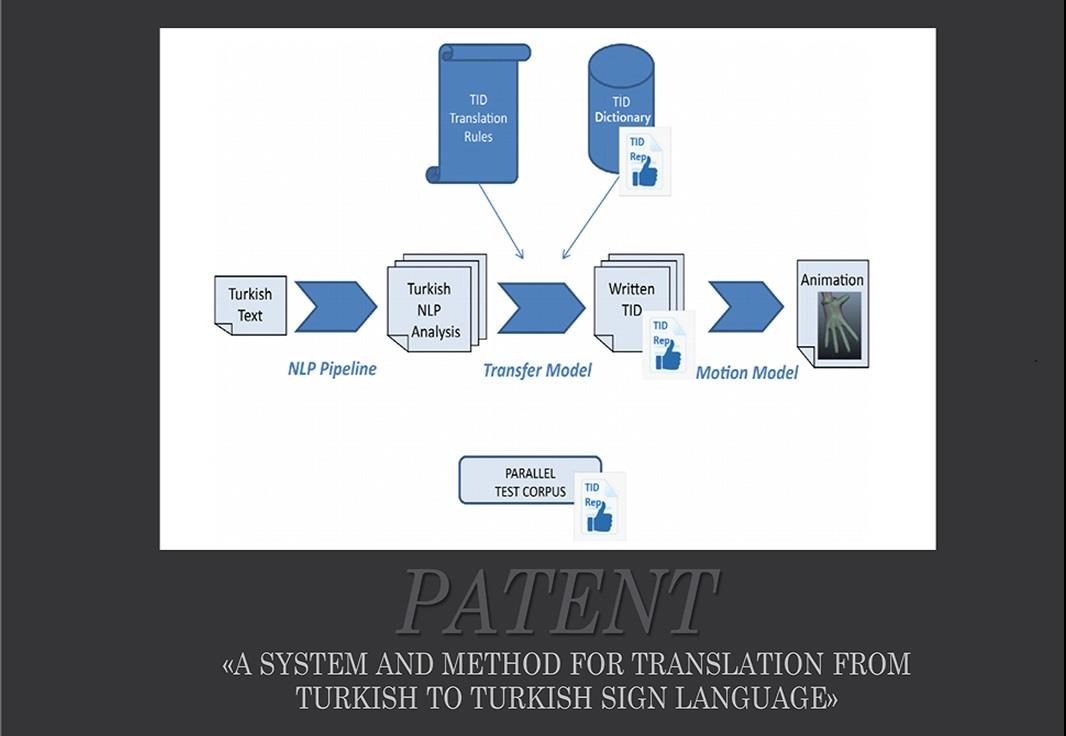The invention of Prof. Dr. Hatice Köse and Assoc. Prof. Dr. Gülşen Eryiğit, was granted a Patent with Examination by the Turkish Patent and Trademark Office.
The invention
“System and Method of Translation from Turkish to Turkish Sign Language and Visualization through Animation”, whose inventors include our faculty members
Prof. Dr. Hatice Köse and
Assoc. Prof. Dr. Gülşen Eryiğit, was granted a Patent with Examination by the Turkish Patent and Trademark Office.

Researchers from human-robot interaction and natural language processing teams at ITU and linguistics research group at Boğaziçi University participated in the project conducted by Istanbul Technical University.
Domestic Software in the Field of Natural Language Processing
The invention subject to application concerns a system and method of computerized translation that provides the translation of Turkish into Turkish Sign Language and mainly includes the steps of processing words in Turkish materials through various natural language processing modules, simplifying/splitting long sentences that cannot be directly translated into Turkish Sign Language into sub-sentences, transforming the simplified sub-sentences into Turkish Sign Language representation in a machine-readable written format by using a transfer model, and visual presentation of Turkish Sign Language transformed into written format by transferring to animation environment.
Software that overcomes obstacles
The patent is the outcome of the project “A Signing Avatar System for Turkish to Turkish Sign Language Machine Translation”, which is the only project supported among more than 100 project applications within the framework of TÜBİTAK 1003 Human-Computer Interaction call in 2014. In the project whose principal investigator is ITU faculty member Assoc. Prof. Dr. Hatice Köse, a translation and visualization method was designed and developed to minimize the difference between the reading-writing learning times of primary school level children with hearing impairment and children with normal development, and thus to eliminate the educational disadvantage of children with disabilities. Articles in high impact factor journals and conference papers were published, graduate students were raised and invited speeches were given in this field. With this project, important steps were taken for visualization of Turkish Sign Language and a domestic and national translation system and software platform was implemented towards increasing the socio-economic level of individuals with disabilities.
Prof. Dr. Hatice Köse’s studies in the field of social robot-supported education and health for children with hearing impairment and autism aim to recognize sign language and movement through artificial intelligence-based approaches, to implement with humanoid robots and avatars, and to understand the mood and motivation of children through robotic sensors and to exhibit behavior accordingly. Her project with children with hearing impairment is a first in the world.
Assoc. Prof. Dr. Gülşen Eryiğit has been working on Turkish for 20 years in the field of Natural Language Processing, a technology that needs to be developed domestically for each language. In this sense, studies conducted under the leadership of Assoc. Prof. Dr. Gülşen Eryiğit are of great importance in terms of filling the gap in Turkey.
Dr. Cihat Eryiğit made research on the parts of the invention other than avatar animation, namely machine-readable representation, ontology and translation of Turkish Sign Language (TSL) in his Ph.D. thesis titled “Text to Sign Language Machine Translation System for Turkish” (supervisor: Prof. Dr. Hatice Köse), which he completed in ITU Computer Engineering graduate program.
Prof. Dr. Meltem Kelepir from Boğaziçi University makes research on TSL grammar (syntax and semantics) and has served as researcher and principal investigator in national and international projects focusing on sign language linguistics.